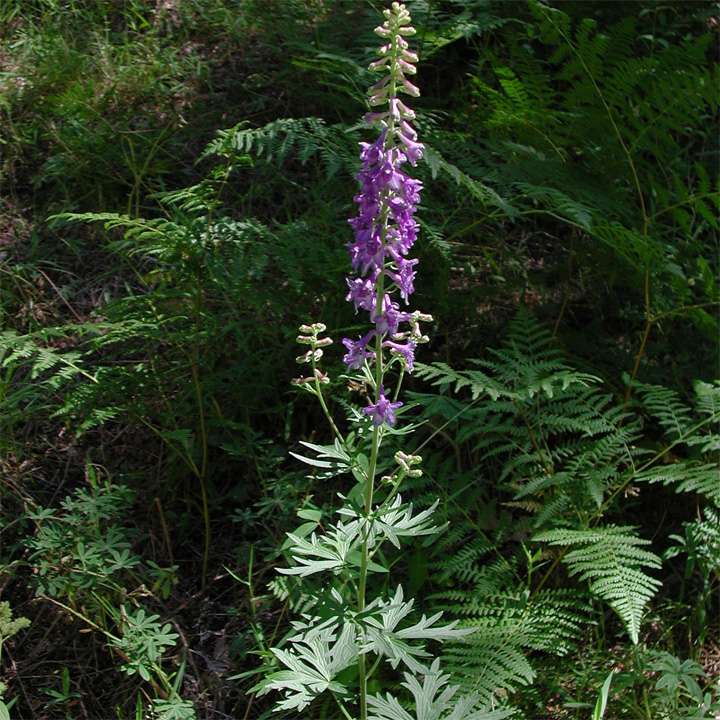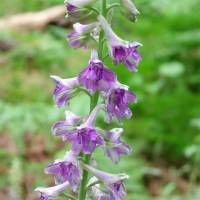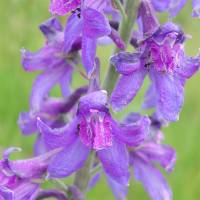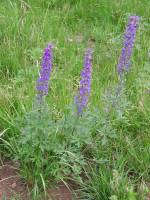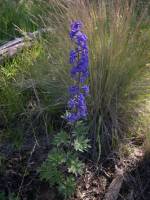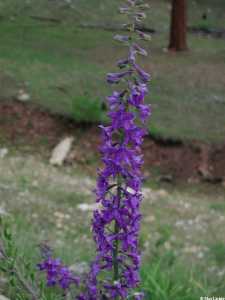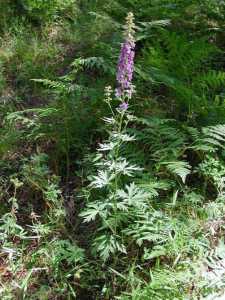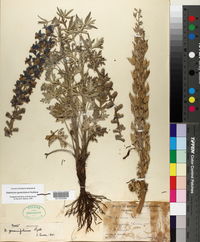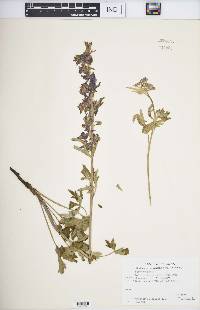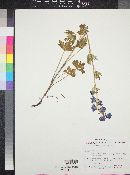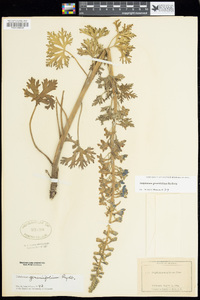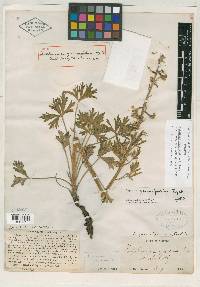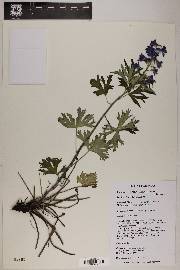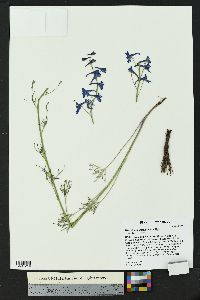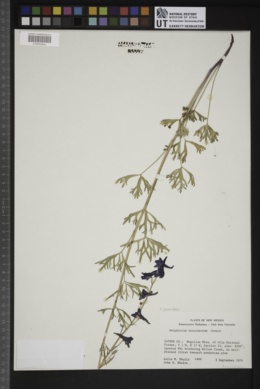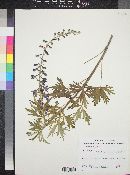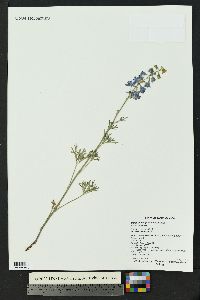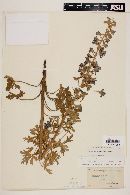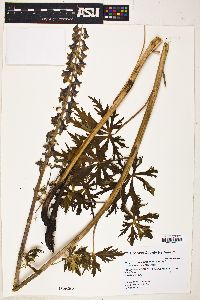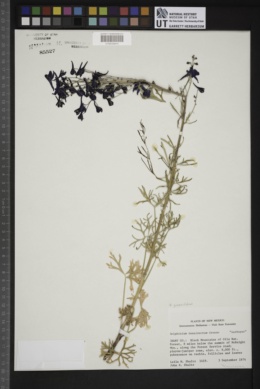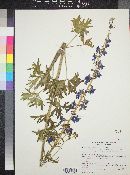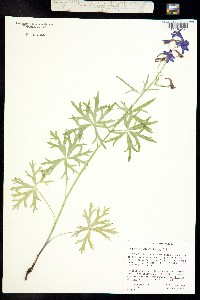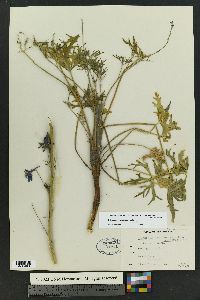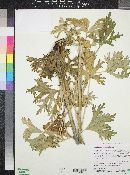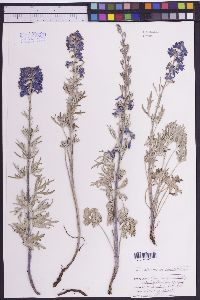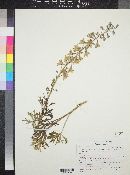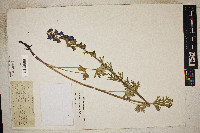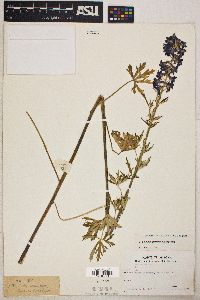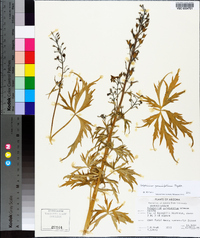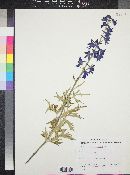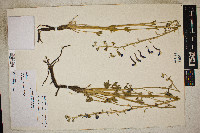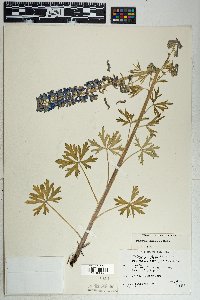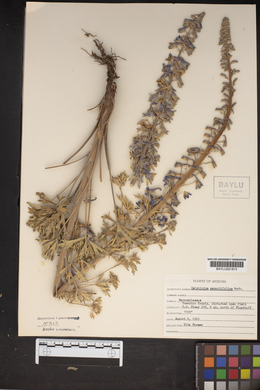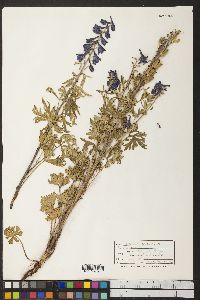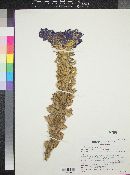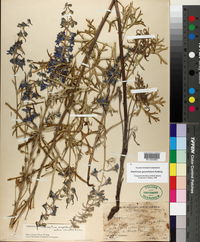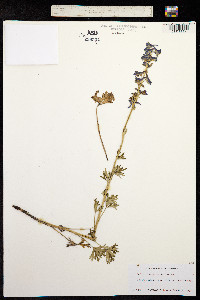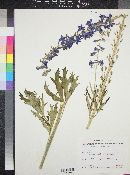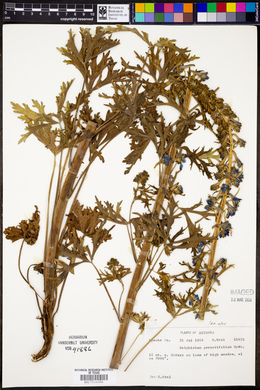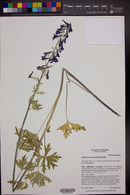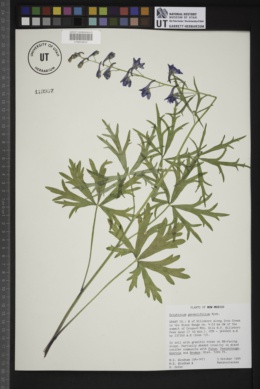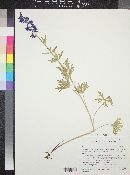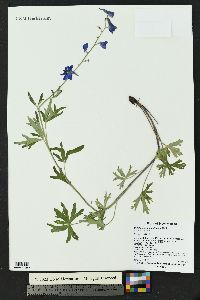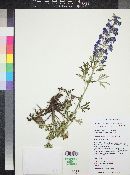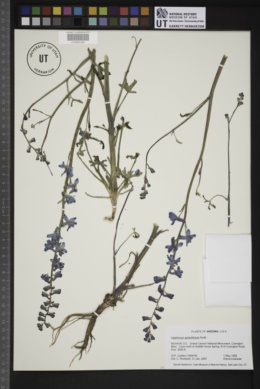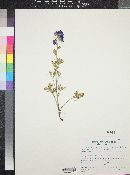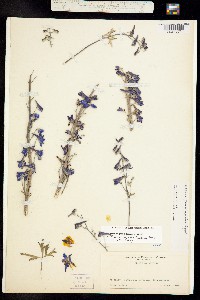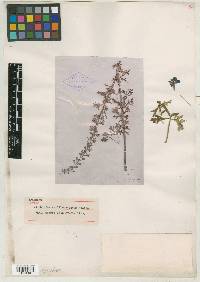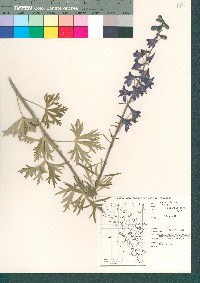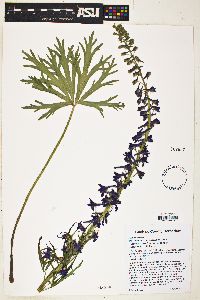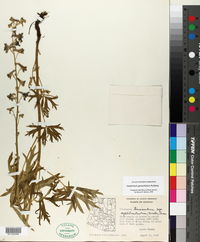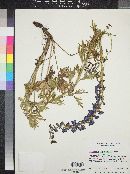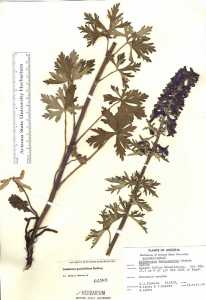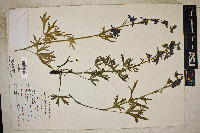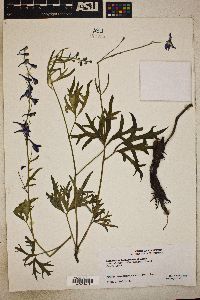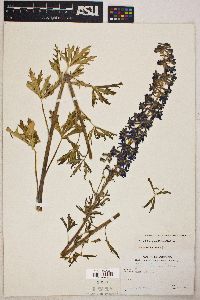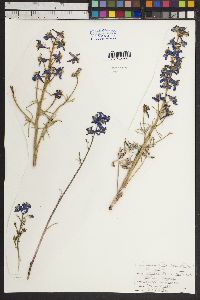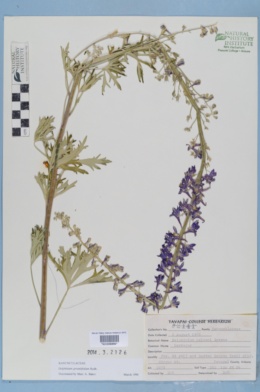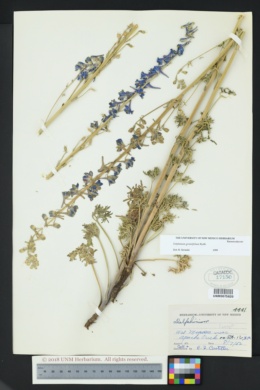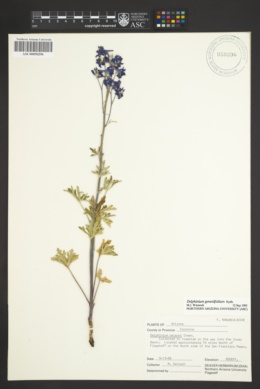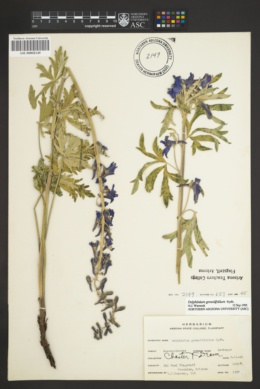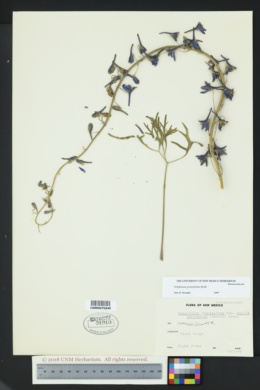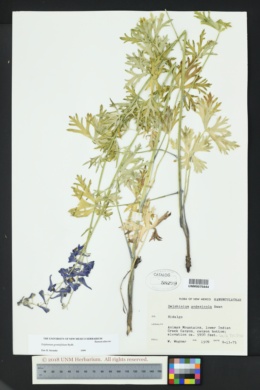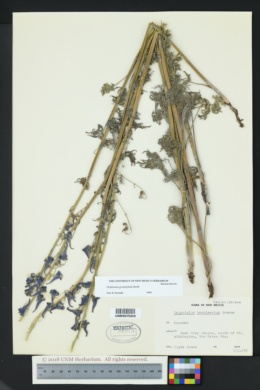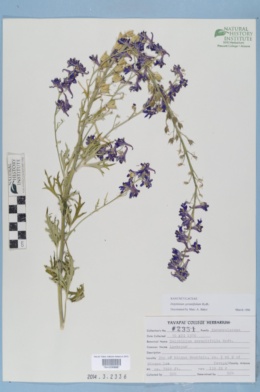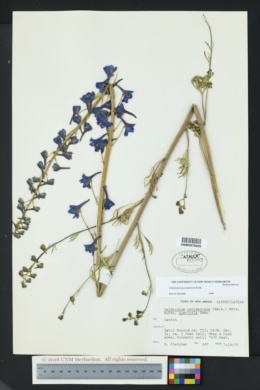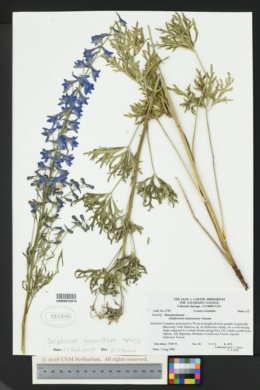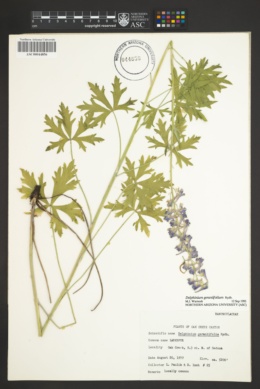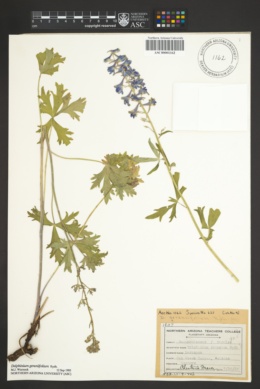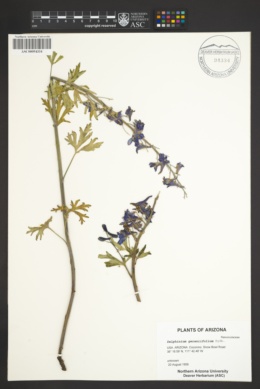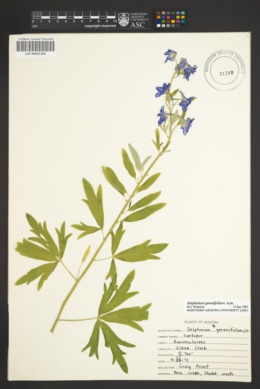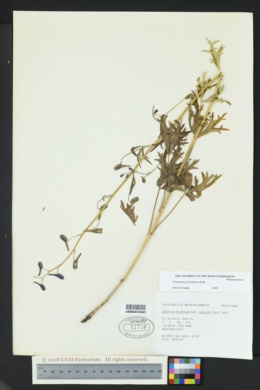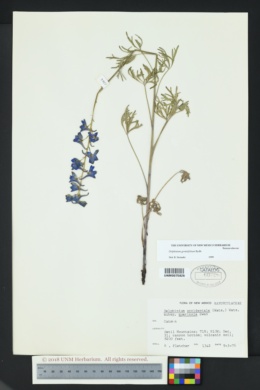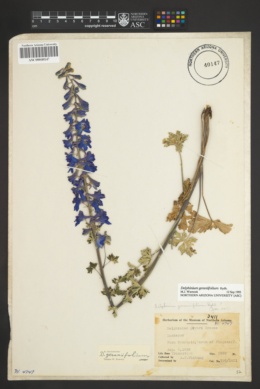
|
|
|
|
Family: Ranunculaceae
Clark Valley Larkspur
[Delphinium amplibracteatum Woot., moreDelphinium tenuisectum subsp. amplibracteatum (Woot.) Ewan] |
Stems 60-100 cm; base reddish, puberulent, midstems pubescent. Leaves mostly on proximal 1/3 of stem; basal leaves (0-)2-7 at anthesis; cauline leaves 12-20 at anthesis; petiole 1-14 cm. Leaf blade dark green, at least adaxially, fan-shaped to reniform, 2-5 × 3-7 cm, pubescent, especially abaxially; ultimate lobes 5-15, width 4-15 mm (basal lobes 5-15 mm), apex abruptly tapered, usually mucronate; veins prominent. Inflorescences 20-90-flowered, dense, cylindric; pedicel ascending to spreading, 1-2 cm, puberulent; bracteoles 1-2 mm from flowers, green, linear, 4-6 mm, puberulent. Flowers: sepals dark blue to purple, puberulent, lateral sepals spreading to slightly forward pointing, 10-14 × 3-5 mm, spurs ascending 20-70° truncate or downcurved apically, 12-15 mm; lower petal blades slightly elevated, ± exposing stamens, 4-6 mm, clefts 0.5-2 mm; hairs sparse, local below junction of blade and claw, scattered on margins, white. Fruits 13-18 mm, 3-3.5 times longer than wide, puberulent. Seeds unwinged; seed coat cells with margins straight, surfaces ± roughened. 2 n = 16. Flowering summer. Heavy clay soil, dry meadows in coniferous woods; 1800-3400 m; Ariz, N.Mex. Delphinium geraniifolium is a more pubescent analog of the closely related D . scopulorum , the former occurring in heavier soils at higher elvation.
General: Perennial, 60-100 cm tall; stems usually solitary, stout, usually unbranched, base reddish puberulent, midstem pubescent; stems not separating easily from the roots. Leaves: Basal and cauline, mostly on the lower 1/3 of the stem, alternate, fan- to kidney-shaped in outline, 2-5 cm long, 3-7 cm wide, dark green above, paler below, pubescent, especially below, lobes 5-15, wedge-shaped, 4-15 mm wide, the ultimate margins lobed and toothed, the tips usually mucronate; blades petiolate. Flowers: Inflorescence a raceme, simple or with up to 3 branches, 6-30 flowered, these bilateral; bracts subtending the inflorescence with 3 or more lobes; pedicels ascending- spreading, 1-3 cm long, more-or-less puberulent; sepals 5, blue to purple, rarely pink or white, the lower two and lateral two 8-18 mm long, the upper one spurred, the spur 12-20 mm long; petals 2, connate, spurred, the spur enclosed in the upper sepal, same color as sepals or whiter; pistil 1; flowers July-October. Fruits: Aggregate of follicles, 13-18 mm long, 3-3.5 times longer than wide, puberulent; seeds numerous, dark brown, more- or-less roughened. Ecology: Mountain meadows, coniferous forests; (5000-9500 ft); Apache, Cochise, Coconino, Gila, Greenlee, Navajo, Pima, and Yavapai counties; southwestern U.S. Notes: Delphinium scopulorum (Rocky Mountain larkspur) is very similar to D. geraniifolium, but is distinguished by the midstems and leaf blades being glabrous or nearly so, inflorescence 10-30 flowered, open, and sepals bright dark blue. It occurs in riparian forests and woodlands, and is more common in southern Arizona and northern Mexico, but does extend peripherally into our range. Two other species, also on the periphery of our range, are differentiated as follows: D. barbeyi (subalpine larkspur, tall larkspur) has lance-acuminate sepals, the hairs of the inflorescence are lustrous, glandular, and spreading, the follicles are nearly glabrous, bearing dark veins, and it occurs in subalpine and alpine habitats; and D. andesicola (Chiricahua Mountain larkspur) has ovate sepals, the hairs of the inflorescence are not glandular, the follicles are puberulent, and it occurs in meadows and coniferous woods. Delphinium andesicola is known to hybridize with D. scopulorum. Editor: Springer et al. 2008 |
This project was made possible in part by the Institute of Museum and Library Services [MG-70-19-0057-19].
Powered by Symbiota

